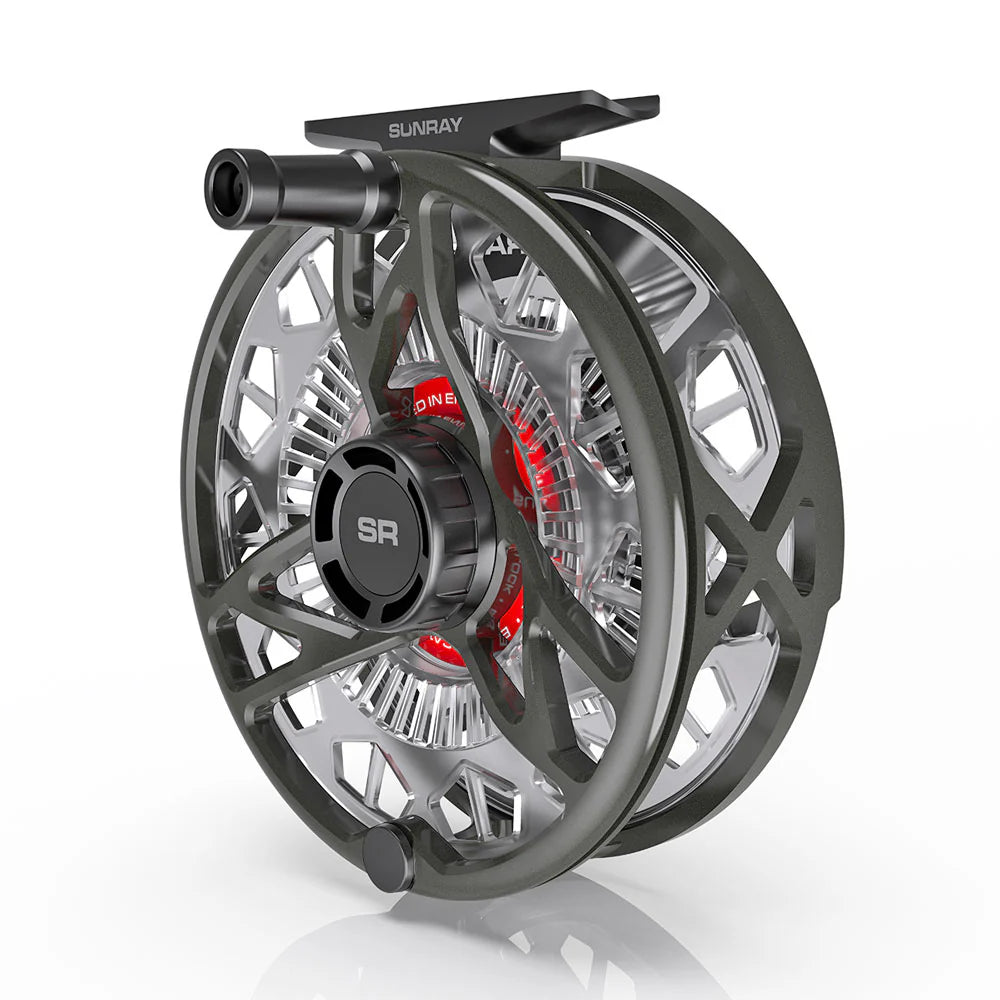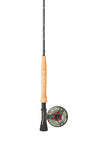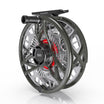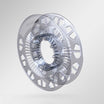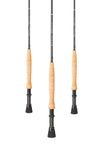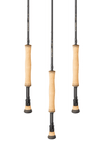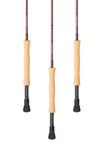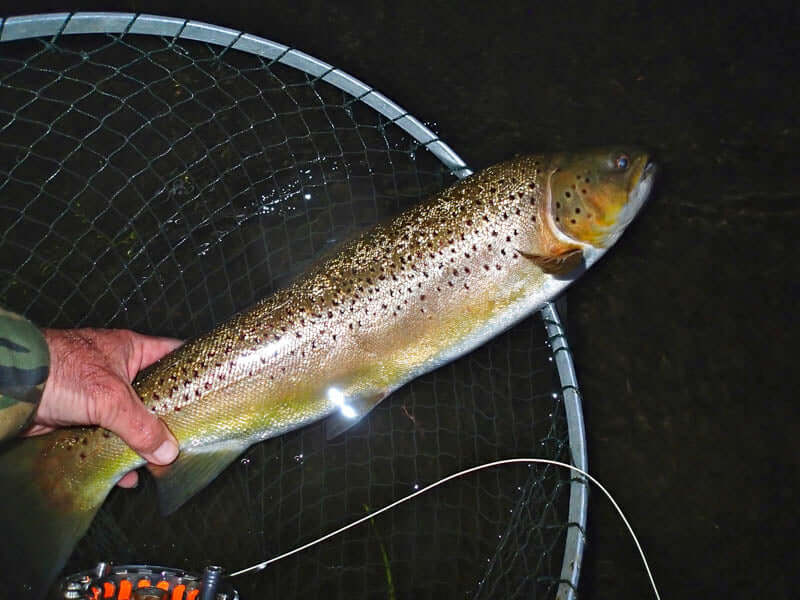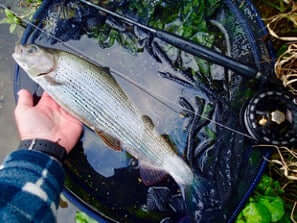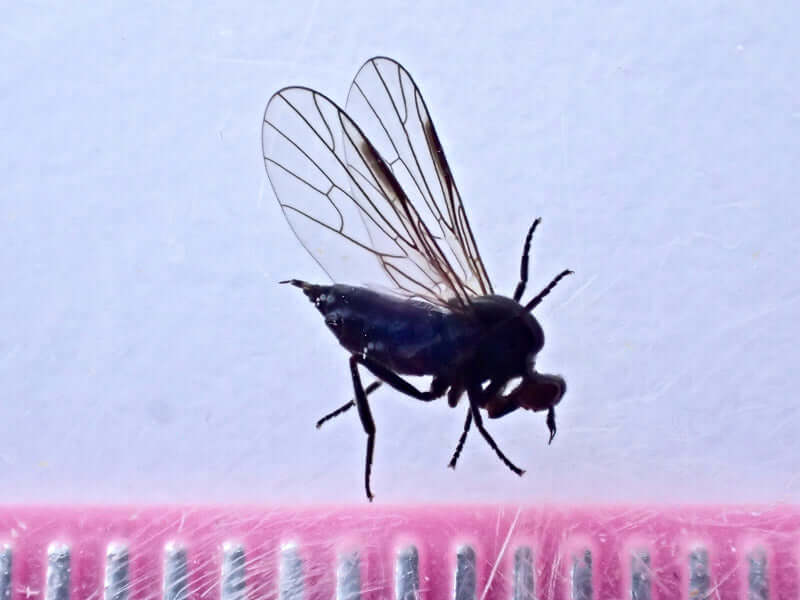by Dave Southall
Since I live close to the two most northerly chalk streams of any significance, Driffield Beck & Foston Beck, in East Yorkshire I rather take for granted the optimum techniques for success on this type of water. However in the summer of 2019, whilst guiding a Wild Trout Trust Auction day on Driffield Beck for a Scottish fly fisher who had never before fished a chalk stream I was reminded how very different one’s approach must be on these relatively placid, weed-rich, gin-clear streams compared with the typical spate stream where the fish are much harder to see & the habitat more varied. I hope that my thoughts & observations might be of some help to those folks visiting a chalk stream for the first time.
VISIBILITY is probably the most significant factor when fishing a chalk stream. Generally the water is gin-clear (except during high water in the late winter when there may be some suspended silt). This is a mixed blessing since not only can the angler easily see the fish but the fish can easily see the angler. As a result great stealth is needed to avoid spooking one’s quarry (see my earlier blog from 2017 on stealth). Unlike spate rivers, where non-rising fish can’t usually be seen, blind search-fishing on a chalk stream is generally counterproductive since many fish will be scared by inaccurate casting & the angler being seen. It is far better to visually search from a hidden vantage point using polaroid glasses until a fish is located. If a located trout is above mid-water it is likely to be susceptible to a dry fly or a subsurface offering, whilst if it is near the riverbed & if it is active a subsurface offering is more likely to be effective. Which ever of these is the case accurate casting is made much easier as the fish’s location is known. This is particularly important if the fish is not staying ‘on station’ but is cruising about, as often happens in slow water areas. I know that search-fishing on spate rivers is generally conducted in some sort of logical way, for example casting to likely fish-holding spots such as the seam between fast & slow water, the front of boulders & along marginal tree roots, but it is still a somewhat ‘chuck it & chance it’ method. Sight-fishing in the clear water of chalk streams (or in the gin-clear streams of New Zealand) is much more precise; as such it requires a high level of casting skills with regard to accuracy.
Sight-fishing with nymphs is particularly skillful as it requires the ability to determine the precise location & depth of the fish, calculating the effects of refraction which makes a subsurface fish appear to be further away than it is & nearer to the surface. The angler must then choose a fly that will sink to the required depth, bearing in mind the fly’s weight, surface profile (smooth & drag-free like a Perdigon Nymph or spiky & water resistant like a buggy weighted Spider pattern or Hare’s Ear Nymph), the thickness of the tippet (thick tippets resist sinking of the fly) & the flow. Once the right fly has been chosen then it must be cast accurately to a spot where it will have time to sink to the right depth & far enough upstream that it will not scare the fish. Next, if the ‘induced take’ technique is to be used (often more effective than a ‘dead-drift’ when nymphing) the fly must be subtly lifted just before it reaches the fish. Finally any indication that the fish has taken the fly must be reacted to immediately with a lift of the rod (an opening mouth or sudden change of orientation etc.).

- A highly visible big Driffield Beck trout
Chalk streams with their relatively constant water temperature summer & winter (water comes out of the springs at a constant 10 degrees C) & alkaline waters provide RICH FEEDING. As a result the fish can gorge on abundant food organisms when they are vulnerable (for example when Olives or Caddis are hatching, when there is a fall of Hawthorn Flies or Black Gnats or when spent Blue-winged Olive have died after egg-laying). Thus the fishing on chalk streams is ‘HATCH-LED’. Unlike many spate rivers where food is generally less abundant & there are usually a few fish feeding even during ‘quiet times’ there are many times on a chalk stream when the fish are tucked away in their resting lies & not a single fish is feeding or visible. At such times all you can do is wait for any feeding period. Ask for advice from those who know the water on when you should concentrate your efforts as there is nothing worse than spending fruitless hours only to find that you went home just before the action started or that you are too tired to fish effectively when the fish come ‘on feed’. For example on several of my days fishing in late summer 2019 on both my local chalk streams & the River Itchen the main period of fish activity was between 11am & 2.30 pm when a few Olives & Agapetus caddis pupae were emerging: outside of this time slot the fishing was dour.
WEED GROWTH on chalk streams can be extensive which is another mixed blessing. The weed provides food & shelter for huge numbers of aquatic organisms (Olive nymphs, Gammarus/Shrimps, caddis larvae etc.). It also provides cover for the fish from predators such as cormorants (a huge problem on my local rivers). Unfortunately the extensive weed growth can make presentation of a fly very difficult as a plethora of surface currents can result in virtually immediate drag to a dry fly, whilst subsurface flies may catch up on the weed. In addition it can result in the loss of fish, particularly the big ones. I usually fish with relatively heavy tippet (5x or thicker), even though this impedes my presentation (as mentioned before, I often tie my flies into a Rapala Loop Knot to give them ‘free movement’ when using particularly thick tippet compared to the fly size).

- Heavy summer weed growth on Driffield Beck
RULES vary considerably from chalk stream to chalk stream but are generally far more restrictive than on spate-rivers. Some waters restrict the angler to UPSTREAM DRY FLY ONLY. This can be very limiting since fly hatches have declined dramatically over recent years on many chalk streams due to the combined effects of pollution, siltation & reduced flows. Furthermore whilst casting upstream reduces the risk of the fish seeing the angler some fish may be lying in positions that are unreachable with an upstream approach & often on bigger rivers an across & downstream cast will offer a far better chance of a drag-free drift. In some cases UPSTREAM NYMPHING is allowed after the first of July (when the Mayfly hatch has finished), whilst others allow the upstream nymph at any time during the fishing season, although in some cases only unweighted nymphs are permitted. Maximum hook size may also be restricted. Just a few waters allow any angle of approach with any type of artificial fly. Wading is another thing that may or may not be allowed & this can vary from beat to beat even on the same water. So it is important for those new to chalk streams to make themselves aware of the rules.
BROWN TROUT are the main species targeted by chalk stream fly fishers & their behaviour is very different from the grayling. Look for them tight against bankside cover (reed beds, overhanging willows, undercut banks etc.), in front of weed-beds & in channels between the weed, anywhere that there is cover close by. The big trout are also, in my experience, more inclined to rise to the surface fly than are big grayling. My first approach to any chalk stream is to fish a dry fly whenever possible as it is far easier than nymph fishing as explained earlier.

- A big Driffield Beck trout located during the day but caught at dusk with a big Sedge
GRAYLING used to be treated as vermin in the UK (although not in Europe) but fortunately times have changed & now many of us consider grayling to be at least on a par with if not above the brown trout (Charles Ritz, in his book A Fly Fisher’s Life’ considers the grayling as a superior & more challenging quarry than the trout). Grayling generally prefer more open locations than brown trout so expect to see them in the decent sized gravel patches where they can easily see other shoal members & any predators. This behaviour pattern unfortunately makes them much more vulnerable to cormorant predation as they don’t usually bolt for cover. As a result the grayling population in Driffield Beck has been reduced by well over 95% over recent years, leaving mainly very small fish & just a very few huge ones (some over 3lb). The main diet of the grayling in my local rivers is Gammarus/Fresh water Shrimps & fishing with a dry fly rarely results in the capture of the big ones.

- Gin-clear water & a River Itchen grayling
TACKLE, choice is a very personal thing but with gin-clear, relatively placid waters my choice is to fish as light as possible since there have been occasions when I’ve seen fish spook when even a 1 weight line & 18’ leader has landed on the water. On the bigger rivers I opt for a 10’ 4 weight Sunray Microlite, or 10’ 2 weight Sunray Volition, whilst on the smaller, more overgrown streams I generally use an old 8’ 1 weight. Which ever rod I use it is usually teamed up with a Sunray Jeremy Lucas 1 weight or 0 weight Micro Thin line, plus a 7’ tapered section from 0.43mm diameter at the butt to 0.20mm at the tip where I tie a small Perfection loop to which I attach anything from 3’ to 7’ of tippet depending on the wind strength & rod length. Fishing light does not however mean fishing with light tippet & when possible I use 5x or even 4x tippet as being the best compromise between presentation & the strength to cope with big fish in weedy conditions. You may consider such light setups to be a disadvantage in windy conditions but with the Italian Style of casting I can cope with all but the worst wind. If the wind is strong I turn to my 10’ 4 weight Microlite rod & a Sunray Jeremy Lucas 3 weight line plus the above leader setup or in really extreme conditions my 7’ 6” Italian Style rod, 3 weight DT line & 16’ aggressively tapered leader. When I am specifically targeting a known very big fish I will choose my 9’ 6 weight rod teamed up with a 4 or 5 weight line & 3x tippet.

- 8’ 1 weight rod used with a 1 weight Sunray Jeremy Lucas line & 14’ leader on a very narrow Foston Beck in East Yorkshire
Choice of FLIES depends much on the river & the time of year/day. I would not be without a suitable Olive Dun imitation (Jack Tucker’s CdC IOBO Humpy in sizes 20 to 16), an Olive Emerger (Shuttlecock in sizes 20 to 16), Hawthorn fly (size 14), Black Gnat (size 18 or 20), Adult Caddis (F Fly & Elk Hair Caddis in sizes 16 to 12), Agapetus Caddis Pupa (Stuart Crofts’ Agapetus Pupa size 20)(see my earlier blog on Agapetus, a very important & neglected insect!!!!), a Midge pattern (IOBO Humpy size 24 & CdC Minimalistic Micro-Midge size 30), a Mayfly pattern for those rivers that have big Mayflies (mine is tied on a size 14 short-shank hook with an extended chenille body – see my earlier blog on Mayflies), Nymphs (Sawyer’s Pheasant Tail & Bead-head Nymphs in sizes 20 to 16), Silver-bead Partridge & Hare’s Ear Spider, Shrimps (Pink, Orange & Natural coloured in sizes 18 to 12), Peeping Caddis (sizes 16 to 12 long-shank with split shot weight from number 10 to AA). This is not an exhaustive list & my most used flies are printed in BOLD & UNDERLINED.
So, in conclusion, time spent watching carefully till a feeding fish is located is of prime importance when chalk stream fishing; it is not wasted time despite the oft quoted comment “ You will only catch fish when your fly is in the water’. Equally important is the avoidance of doing anything that will scare the fish. A scared fish may not bolt for cover but it will certainly stop feeding. If you scare a particularly big fish give it time to recover & settle back into a feeding routine before your next cast: with the stable conditions of a chalk stream big fish will often use the same feeding lie for weeks or even months.


